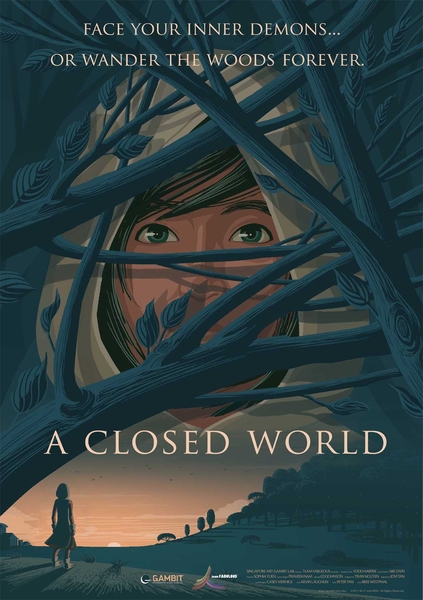Lesbian, gay, bisexual and transgender (LGBT) content has found acceptance in every medium of American popular entertainment ... that is, all but one: video games.
New research efforts at MIT takes that problem head-on.
The Singapore-MIT GAMBIT Game Lab, with its newly released game “A Closed World,” seeks answers to seemingly straightforward questions: How can video games present LGBT content? What are the challenges that a development team faces when trying to include content about someone different from the perceived norm?
To answer these research questions and others, teams worked for a demanding eight weeks during GAMBIT's summer program as producers, designers, programmers, musicians and artists on experimental games. Todd Harper, the GAMBIT product owner of “A Closed World,” led a team of nine interns, hailing from Singapore, MIT, the Rhode Island School of Design and the Berklee College of Music.
“This project addresses a very basic idea about identity and representation in mass media. Think about the first time you heard someone famous was different in the same way as you, or saw someone different in the same way on TV or in a movie. It gave you a little rush of good feeling,” Harper says. “This is the way I sold the project to the interns. Cultural content shapes our reality.”
As the GAMBIT website describes the game:
How did it ultimately go? You’ll have to play “A Closed World” to find out:
Harper tells an inspiring story about the moment when his diverse team of interns — from anime fans and linguistics majors to musicians and software engineers — really came together:
New research efforts at MIT takes that problem head-on.
The Singapore-MIT GAMBIT Game Lab, with its newly released game “A Closed World,” seeks answers to seemingly straightforward questions: How can video games present LGBT content? What are the challenges that a development team faces when trying to include content about someone different from the perceived norm?
To answer these research questions and others, teams worked for a demanding eight weeks during GAMBIT's summer program as producers, designers, programmers, musicians and artists on experimental games. Todd Harper, the GAMBIT product owner of “A Closed World,” led a team of nine interns, hailing from Singapore, MIT, the Rhode Island School of Design and the Berklee College of Music.
“This project addresses a very basic idea about identity and representation in mass media. Think about the first time you heard someone famous was different in the same way as you, or saw someone different in the same way on TV or in a movie. It gave you a little rush of good feeling,” Harper says. “This is the way I sold the project to the interns. Cultural content shapes our reality.”
As the GAMBIT website describes the game:
“A Closed World” is an console RPG-like game that puts the player in the shoes of a young resident of a village. Just outside is a forest that everyone says is a place of no return; the forest is forbidden and nobody knows what's on the other side. However, our hero's beloved — tired of the oppressive attitude of the villagers — decides to go there, as anywhere would be better than home. Now it's your turn to follow after. Are you willing to risk everything to find out what's on the other side?Harper argues that LGBT content, if it shows up in a popular game at all, is usually incidental and never drives the story: “Rather than having it be sidelined or there for a one-off joke, games can and should be doing something explorative and expressive on the topic." However, a clear call to action can’t mask the difficulty of making such a game. “We started with my having mapped out the narrative of the game ahead of time,” Harper says. “But in eight weeks we'd done something completely different.”
How did it ultimately go? You’ll have to play “A Closed World” to find out:
Harper tells an inspiring story about the moment when his diverse team of interns — from anime fans and linguistics majors to musicians and software engineers — really came together:
The very first week of the summer program where all the interns are in Boston usually coincides with Boston Pride. This year the Boston Pride Parade was the very weekend after the Singapore students stepped off the plane and into orientation.“It's not an easy topic,” Harper concludes, “and people come into the situation with lots of different expectations and backgrounds. But they embraced it as a team.” Which is exactly what should happen in the development of new games with characters different from the norm.
In the workroom that week, I heard chatter about people going and mostly assumed it would be one or two interested parties who would want to see it. I planned on going myself, in fact, but it was pouring rain and I had no umbrella. I mostly waited around hoping the rain would stop.
The following Monday, I came back into the office and stepped into the workroom...which now had a pride flag (the 6-color rainbow flag) on the door, a series of them on impromptu flagpoles attached to the walls, and a giftbag from the Human Rights Campaign sitting on the work table. Apparently, they all went, as a group. In the rain. Once I got over the moment of shock, I really felt a smile slowly spread across my face. And it wasn't the last of such things that happened, either; I know they had a night dedicated to eating ice cream and watching Hedwig and the Angry Inch, for example. They were a super close-knit team, which I think was a tremendous asset in terms of the progress of the project. Plus, it was reassuring to me to see them taking an interest in the 'subject matter,' as it were.






